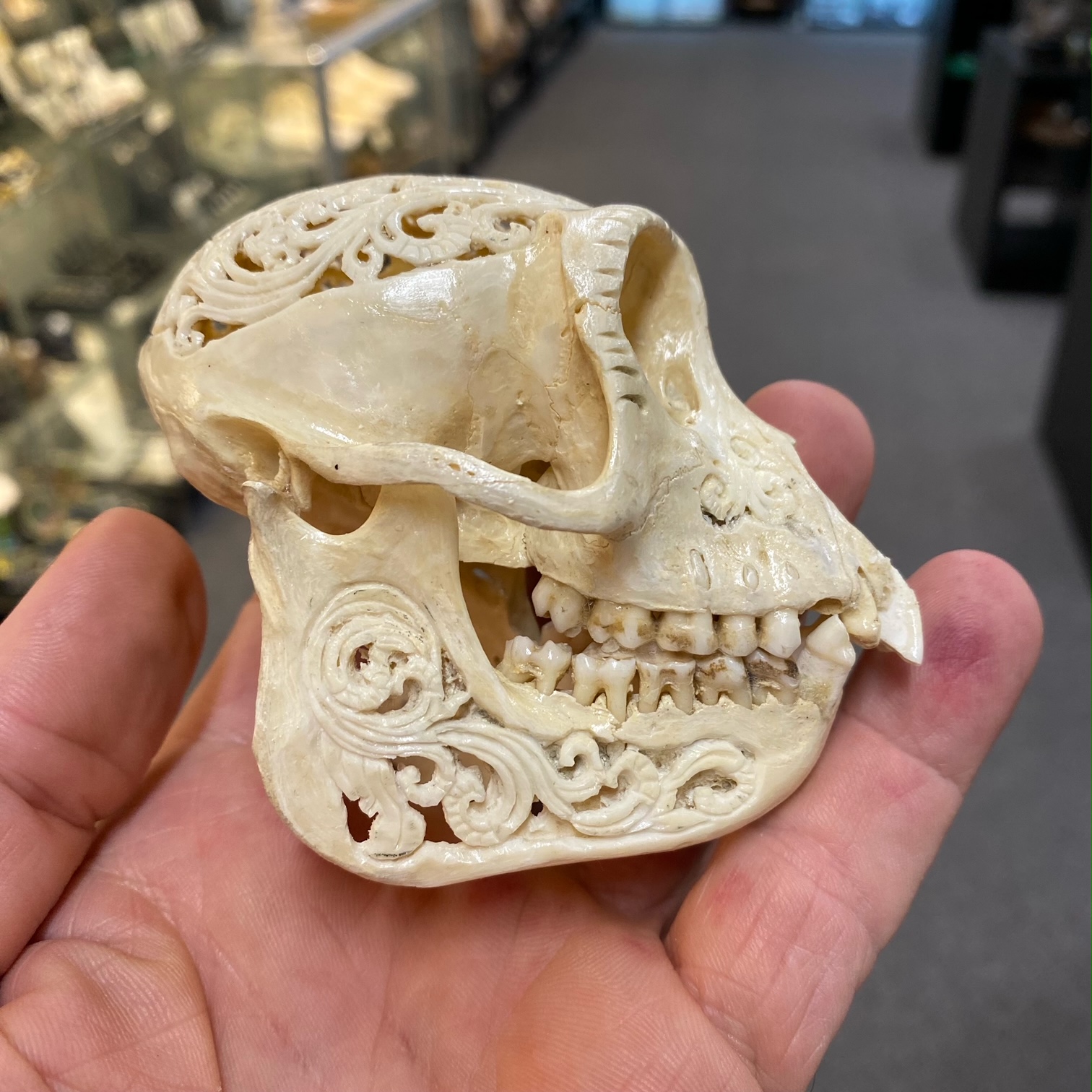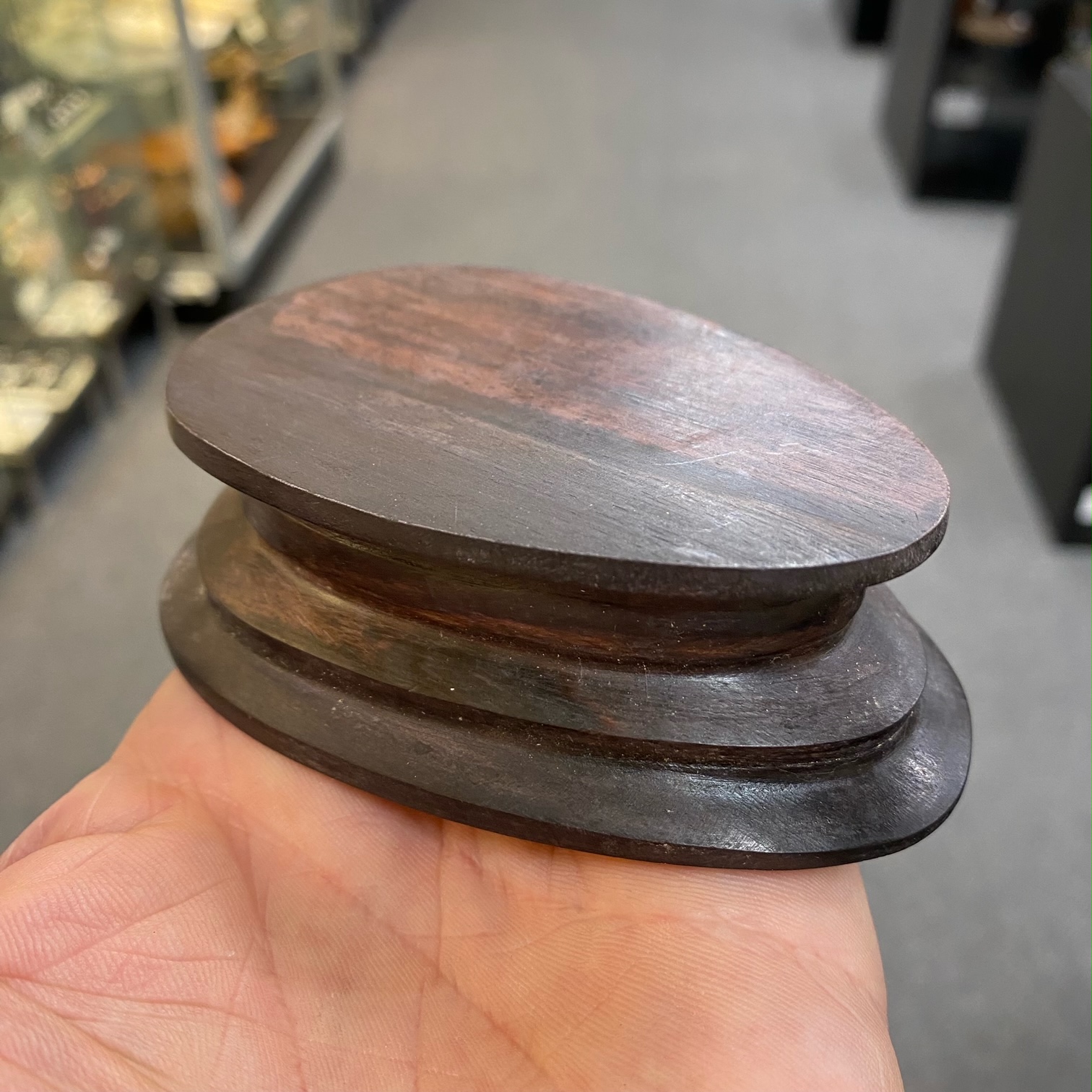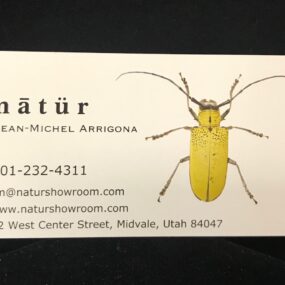Description
Monkey Skull Carved #3, Specimen #3, Wood stand included, Not a perfect skull.
These are real Monkey skulls, but we do not know what species of Monkey this is. We purchase these in the US, but they are carved in Indonesia, and they include a nice wood stand as shown. They are not perfect skulls, and some are missing teeth, etc. Please look at all pictures. You will receive the exact skull shown.
This listing is for this item: Monkey Skull Carved #3
Indonesia is home to a variety of fascinating monkeys, many of which are found only in this region due to its diverse ecosystems. Here are some notable species of monkeys found in Indonesia:
A. Proboscis Monkey (Nasalis larvatus)
- Habitat: Found primarily on the island of Borneo (both Malaysian and Indonesian parts).
- Distinctive Features: Known for their large, distinctive noses (particularly males), long tails, and pot-bellied appearance. The males have a larger nose, which is believed to attract females.
- Behavior: They are arboreal and often live in large groups near rivers, swamps, and mangrove forests. They are primarily herbivores, feeding on leaves, fruits, and seeds.
- Conservation: Considered endangered due to habitat loss and hunting.
B. Long-Tailed Macaque (Macaca fascicularis)
- Habitat: Found throughout Southeast Asia, including the islands of Java, Bali, and parts of Borneo and Sumatra.
- Distinctive Features: These monkeys are medium-sized with long tails and a grey or brownish coat.
- Behavior: They are highly social and adaptable, living in troops. Long-tailed macaques are omnivorous, eating fruits, seeds, insects, and small animals.
- Conservation: They are common and not currently at risk, but they can sometimes cause problems in urban areas due to their adaptability to human environments.
C. Javan Lutung (Trachypithecus auratus)
- Habitat: Native to the island of Java.
- Distinctive Features: Known for their striking orange or golden fur, black faces, and long tails.
- Behavior: Javan lutungs are arboreal and live in small to medium-sized groups. They are primarily herbivores, feeding on leaves, fruits, and flowers.
- Conservation: Considered endangered due to deforestation and habitat destruction.
D. Sumatran Orangutan (Pongo abelii)
- Habitat: Found only in the rainforests of Sumatra.
- Distinctive Features: Orangutans are large, primarily solitary primates with reddish-brown fur. Males have large cheek pads and a throat pouch.
- Behavior: Orangutans are mostly arboreal, spending the majority of their time in trees. They are omnivorous, eating a wide variety of fruits, leaves, and insects.
- Conservation: Critically endangered, with only around 14,000 individuals left. They are threatened by habitat loss due to logging, palm oil plantations, and illegal hunting.
E. Bornean Orangutan (Pongo pygmaeus)
- Habitat: Found in the rainforests of Borneo.
- Distinctive Features: Similar to the Sumatran orangutan, but slightly smaller and with slightly different facial features.
- Behavior: Like other orangutans, they are largely solitary, with adult males sometimes displaying large cheek pads. They mainly eat fruits, especially durian, but also consume bark, leaves, and insects.
- Conservation: Critically endangered due to deforestation and illegal pet trade.
6. Tapanuli Orangutan (Pongo tapanuliensis)
- Habitat: A newly discovered species, found in a small area in North Sumatra, Indonesia.
- Distinctive Features: Smaller and more distinct in appearance than the other orangutans, with a unique skull shape.
- Behavior: Similar to other orangutans, primarily solitary and arboreal, relying on forest habitats for survival.
- Conservation: Critically endangered, with fewer than 800 individuals remaining due to habitat destruction and fragmentation.
7. Crested Macaque (Macaca nigra)
- Habitat: Native to the island of Sulawesi.
- Distinctive Features: These monkeys are known for their black fur and distinctive “crest” of hair on their heads. They are medium-sized with expressive faces.
- Behavior: Crested macaques are highly social, living in groups of up to 30 individuals. They are omnivorous, eating fruits, seeds, leaves, and insects.
- Conservation: The crested macaque is endangered due to habitat loss, hunting, and the illegal pet trade.
8. Sulawesi Black Macaque (Macaca nigra)
- Habitat: Found only on the island of Sulawesi.
- Distinctive Features: A medium-sized monkey with black fur and a rounded face.
- Behavior: Sulawesi black macaques live in forested areas and have a varied diet that includes fruit, leaves, and invertebrates.
- Conservation: Vulnerable due to hunting and habitat destruction, particularly for agriculture and logging.
9. Kloss’s Langur (Trachypithecus klossii)
- Habitat: Found on the Mentawai Islands off Sumatra’s west coast.
- Distinctive Features: Kloss’s langurs have a dark coat and are known for their long, slender bodies.
- Behavior: These langurs are arboreal, feeding on leaves, seeds, and fruits.
- Conservation: They are endangered due to hunting and habitat loss from logging.
Summary
You are purchasing Monkey Skull Carved #3
Indonesia is home to some of the most unique and endangered primates on the planet, many of which are integral to the health of the ecosystems they inhabit. Efforts to protect them are crucial for both biodiversity and the livelihoods of local communities who depend on these forests.
Skull, Snake, Vine Snake skull Dome, Ahaetulla prasina skull in a Glass Dome



























